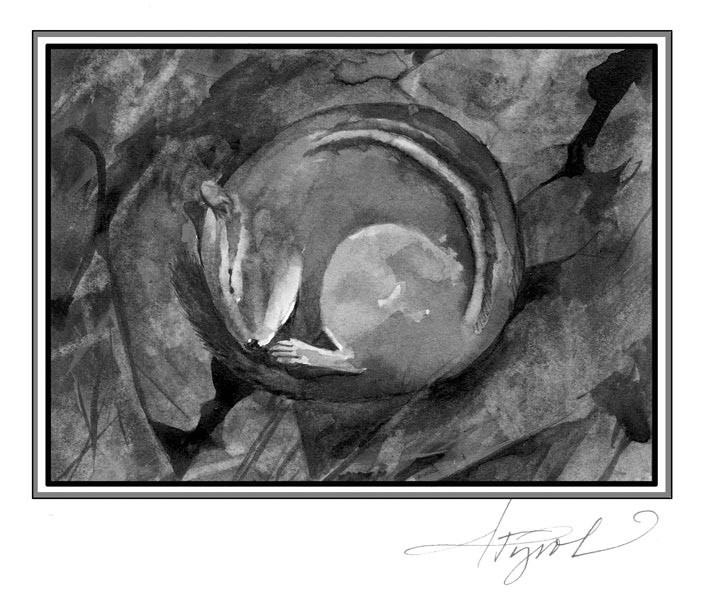
Whenever a frigid overcast day comes along, I develop a powerful urge to return to bed for a spell. So does Monty, the cat, who after rising for breakfast and watching birds through a frosted window, decides he has had enough strenuous activity, and takes a nap. Naps for him are intermittent until evening, when, exhausted, he retires for the full night.
Neither Monty nor I have good reason to feel this way. We are warm, securely housed and well fed. But many of our neighbors in the animal world fare otherwise. Insects, reptiles, amphibians and many species of small mammals require a season-long nap – hibernation – to survive.
From our glances outside today Monty and I see chickadees at the feeders, and a few red squirrels in the yard, but that’s about it. Many northern woodland creatures have tucked themselves away and disappeared now that the ground is blanketed with snow and the skeletal trees glisten with ice.
The mammals among these creatures, such as woodchucks and chipmunks, are hibernating in the secure retreats that they prepared many weeks ago, homes that are insulated to a degree but certainly not heated. Their challenge is to survive winter on the reserves of internal fat built up thanks to the rich larders of summer and fall.
Among mammals, it’s the smaller ones that are true hibernators. And size is a determining factor. With an expansive skin covering relatively small bodies, too much of their body heat would otherwise be lost by radiation into the cold air.
Hibernation allows animals to survive because in this quiescent state they have little need, if any, for high-energy food that in winter is hard to find. Traveling long distances to look for food can require expenditures of more energy than some animals have at their disposal. The search is not worth the effort.
During hibernation the heart rate slows; circulation becomes sluggish; breathing is almost imperceptible; metabolism lowers significantly; body temperature falls; muscle tone lessens, and brain function is minimized. Most hibernators don’t eat or drink anything, and excretion stops, although some small rodents awaken occasionally to dine on stored food. Hibernation is a coma-like state. Come spring, it can take a day or two for recovery.
Large mammals don’t need to hibernate. Because their surface-to-body- volume ratio is much less, they don’t lose as much heat. They also are more adept at finding food: Moose and deer, for example, can find bark, leafless shrubs, twigs, acorns and green plants beneath the snow.
One large mammal in the northern forest, the black bear, hunkers down in a den for a long winter’s slumber that some people mistakenly refer to as hibernation. But since the bear’s body temperature drops only a few degrees and its metabolism remains relatively unchanged this isn’t true hibernation. The sleep, itself, is not as deep as that of smaller creatures. A bear is apt to awaken and even briefly leave its den during a warm spell or if it is disturbed.
Hibernation is not sleep, though it resembles sleep. Some reductions in brain and body function associated with hibernation occur during an eight-hour slumber. But sleep is more a matter of altered brain activity than physiology. Hibernation is a physiological condition controlled largely by pituitary and thyroid hormones and by insulin from the pancreas.
How do animals know when to begin hibernating? They have internal biological clocks keyed to the number of daylight hours. Changes in food supply, temperature and weather also figure in.
The process isn’t immediate. When it turns dark and cold, animals don’t just call it a season and bed down for six months. They must prepare for hibernation. In late summer and fall they improve their dens and nests, insulating them and even camouflaging them against non-hibernating predators. As food supplies dwindle in autumn, they recognize the warning sign and begin gorging themselves to increase internal fat. Some stash away as much dry imperishable food as possible in storage chambers. Chipmunks, for example, will awaken briefly in midwinter to nibble on their stores.
Once in hibernation, a mammal’s well being is controlled by an inborn “thermostat” that kicks in or out depending upon a physiological need to burn fat. This “thermostat” helps maintain the minimum temperature needed to keep metabolism ticking along at a still-reduced level.
Carnivores rarely hibernate. Even under winter conditions a carnivore almost always has some food at its disposal; it has at least some chance of killing another animal—even if it’s just a mouse well-hidden under snow. This is one reason why Monty, no matter how tired or bored, will happily sleep but never hibernate.


Discussion *